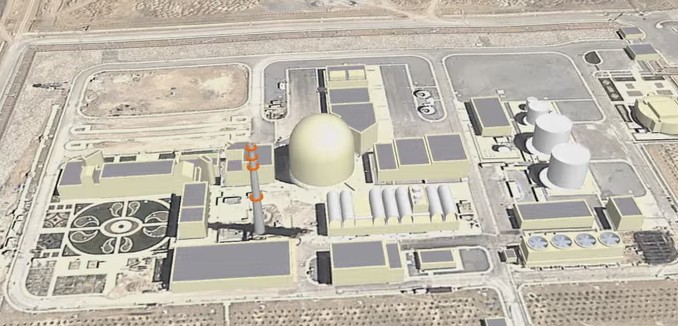A senior Iranian official denied that Iran has deactivated its Arak heavy water reactor, contradicting claims made earlier this week by the semi-official Fars news agency, The New York Times reported Tuesday.
The Fars report, which said that Iran dismantled the core of its Arak reactor and filled it with cement, as per the nuclear deal’s requirements, was dismissed by Iran’s deputy nuclear chief Ali Asghar Zarean.
Zarean added that Tehran planned to sign a deal with China next week to modify Arak, which is capable of producing weapons-grade plutonium.
The nuclear deal requires Iran to ship out most of its enriched uranium, dismantle several hundred centrifuges, and decommission the Arak reactor in exchange for an estimated $100 billion in sanctions relief.
In November of last year, Iran announced that it had stopped dismantling centrifuges at two uranium enrichment plants, despite its obligations under the deal.
In December, the International Atomic Energy Agency’s board of governors voted to close the nuclear watchdog’s investigation into Iran’s past illicit nuclear weapons research. The decision came despite an IAEA report proving that Iran had lied about its past nuclear research and worked on developing a nuclear weapon as recently as 2009.
North Korea’s claim last week that it detonated a hydrogen bomb raised questions on whether the nuclear deal will be able to prevent Iran from developing nuclear weapons. Retired Army Major Gen. Robert Scales told Fox News last week that Pyongyang’s test “says Iran is able to circumvent [the nuclear deal] by using their technological colleagues in Pakistan and their test site facility in North Korea to push their own nuclear ambitions.”
In The Looming Global Nuclear Weapons Crisis, which was published in the January 2016 issue of The Tower Magazine, Emily Landau described how Iran violated the Nuclear Nonproliferation Treaty with impunity and why accepting Iran’s illicit gains undermines the nonproliferation regime.
As such, throughout the twelve years of diplomatic efforts to stop Iran in the nuclear realm, the suspicion that Iran was abusing a purportedly civilian enrichment program for military purposes was uppermost in the minds of the international negotiators. For this reason, all the UN Security Council resolutions against Iran between 2006 and 2010 demanded that Iran suspend uranium enrichment. Iran refused to comply. In addition to building up its stockpiles of low- and medium-enriched uranium, Iran worked to develop much more powerful centrifuges that would be able to enrich uranium as much as 20 times faster than older models.
While international concern grew, Iran was establishing facts on the ground that would be increasingly difficult to undo—from R&D to the installation of centrifuges to the continued enrichment of uranium, as well as work on a separate, plutonium-based program and the development of ballistic missiles that could deliver nuclear warheads. Iran’s gamble proved effective: By the time the P5+1 began their more serious round of negotiations with Iran in late 2013, Iran’s advances were so significant that a growing consensus emerged that the international negotiators could no longer expect Iran to completely dismantle its infrastructure. While not happy with the situation, they assessed that they would have no choice but to leave Iran with some enrichment capabilities. In the face of criticism, the P5+1 insisted that they would only allow Iran a very limited, virtually symbolic program of no more than 1,500 centrifuges at most.
However, once negotiations on a comprehensive deal began in early 2014, the P5+1 began conceding to Iran on this front, and according to details that appeared in the media over the months of negotiations, the P5+1 states were signaling their willingness to leave Iran with ever-growing numbers of centrifuges. The final deal confirmed that the reports were accurate—the deal ultimately left Iran with around 6,000 working centrifuges and a provision that enabled it to continue research and development on an entire range of advanced-generation centrifuge models. Moreover, President Obama assured Iran that it would be able to expand to a full enrichment program once the deal sunsets (in 10 to 15 years), allowing Iran to become a “normal” member of the NPT once again.
The combined effect of these messages was to legitimize Iran’s uranium enrichment program, even though Iran had violated the NPT and lied about its intentions for decades. Legitimizing Iran’s enrichment program also stood in stark contrast to earlier U.S. efforts to prevent other states that were seeking civilian nuclear cooperation from working on the fuel cycle. Indeed, recognizing the problematic loophole created by the NPT, the United States established a most welcome “gold standard” for civilian nuclear cooperation: requiring states that sought such cooperation to forswear uranium enrichment and to rely instead on purchasing fuel on the open market. A case in point was the United Arab Emirates, held to the gold standard in a deal concluded with the U.S. in 2009. Unsurprisingly, not long after the JCPOA was announced, the UAE—a member in good standing of the NPT—announced that it no longer viewed itself to be bound by the gold standard regarding uranium enrichment.
[Photo: Nuclear Threat Initiative / YouTube ]




